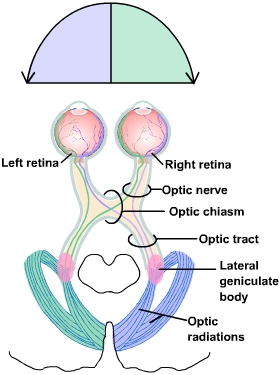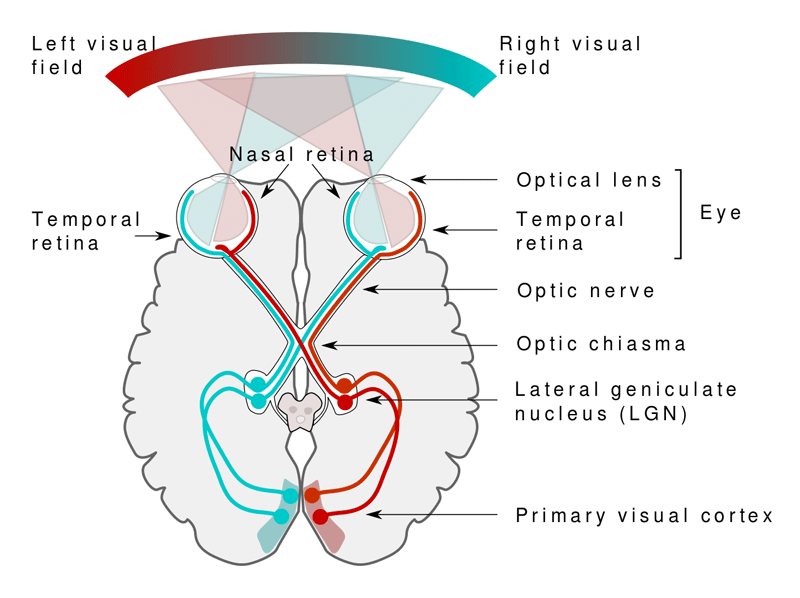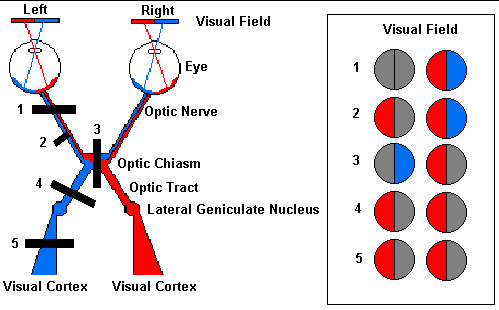The visual system is the part of the central nervous system which enables organisms to process visual detail, as well as enabling several non-image forming photoresponse functions. It interprets information from visible light to build a representation of the surrounding world.

The visual system accomplishes a number of complex tasks, including the reception of light and the formation of monocular representations; the construction of a binocular perception from a pair of two dimensional projections; the identification and categorization of visual objects; assessing distances to and between objects; and guiding body movements in relation to visual objects. The physiological manifestation of visual information is known as visual perception, a lack of which is called blindness.
Non-image forming visual functions, independent of visual perception, include the pupillary light reflex (PLR) and circadian photoentrainment.[1]

The visual system includes the eyes, connecting pathways through to the visual cortex, and other parts of the brain. The neural signals initially processed by the retina travel via the axons of the ganglion cells through the optic nerves, dividing and partially crossing over into the optic chiasm and then travelling via the optic tracts to the lateral geniculate nucleus (LGN). From the LGN, the signals continue to the primary visual cortex, where further visual processing takes place.[2]

 The Visual Pathway: From Eye to Primary Visual Cortex
The Visual Pathway: From Eye to Primary Visual Cortex

What happens if there is damage to the visual pathway?

Different visual problems will occur depending on where the damage is. The black bars (labeled 1 through 5) indicate where damage may occur and the chart to the right of the pathway indicates the resulting "blind" area (gray shading) of the visual field.
Damage at site #1: this would be like losing sight in the left eye. The entire left optic nerve would be cut and there would be a total loss of vision from the left eye.
Damage at site #2: partial damage to the left optic nerve. Here, information from the nasal visual field of the left eye (temporal part of the left retina) is lost.
Damage at site #3: the optic chiasm would be damaged. In this case, the temporal (lateral) portions of the visual field would be lost. The crossing fibers are cut in this example.
Damage at site #4 and #5: damage to the optic tract (#4) or the fiber tract from the lateral geniculate to the cortex (#5) can cause identical visual loss. In this case, loss of vision of the right side. eResearch by Navid Ajamin -- summer 2012
Partial damage to these fiber tracts can cause other predictable visual problem.[3]

Reference:
- en.wikipedia.org/wiki/Visual_system
- emedicine.medscape.com/article/1948576-overview
- faculty.washington.edu/chudler/vispath.html
See Also:
The Visual System for the kids
Reading and the Visual System
Three stages and two systems of visual processing
 وبلاگ تخصصی عینک شامل مجموعه مطالب پزشکی است که اطلاعات مفیدی در رابطه با عینک , چشم، لنز، سلامتی چشم و راه های پیشگیری از بیماریهای چشمی، کنترل و درمان آن را در اختیار شما کاربر محترم می گزارد.
وبلاگ تخصصی عینک شامل مجموعه مطالب پزشکی است که اطلاعات مفیدی در رابطه با عینک , چشم، لنز، سلامتی چشم و راه های پیشگیری از بیماریهای چشمی، کنترل و درمان آن را در اختیار شما کاربر محترم می گزارد.